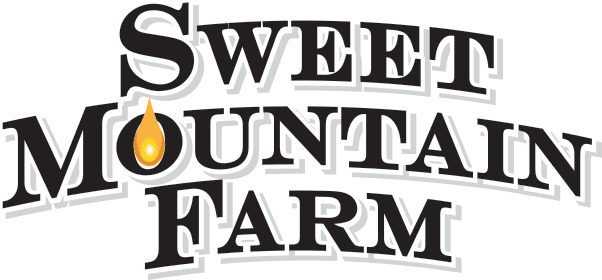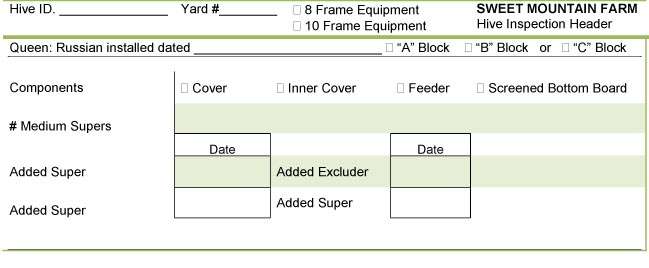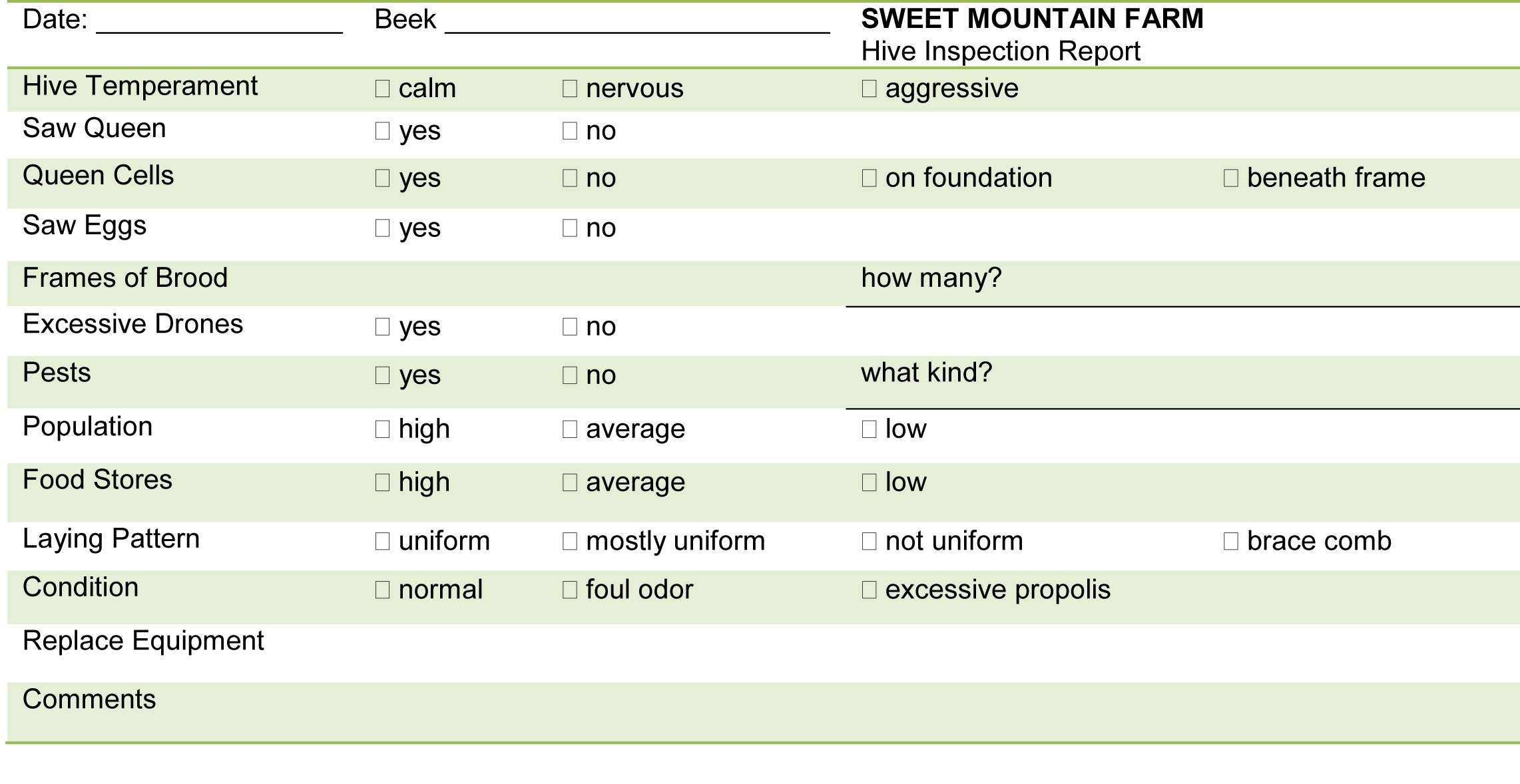IN THE BEE YARD
In the Bee Yard we discuss configuration, inspections, queen rearing, colony splits and pollinator plants.
The Sweet Mountain Farm Russian Bee Yard is shaped in a circle with all entrances facing the center. The configuration is useful for air traffic control.
The circle shape for our Russian Bee Yard reminds me of a Torus. It is a continuous surface with a hole in it. The energy flows in through one end, circulates around the center and exits out the other side. In 1984, Dr. Alexi Starobinski along with his mentor, Dr. Yakov B. Zeldovich professors at Moscow’s Landau Institute, conceived a doughnut theory of the universe. Most apiaries are set up so that the entrances face South, however, we are experimenting with the Torus pattern. It seems fitting to use this pattern in our Russian Bee Yard. We see the Torus pattern throughout nature. You can see it everywhere – in atoms, cells, seeds, flowers, trees, animals, humans, hurricanes, planets, suns, galaxies and even the cosmos as a whole, why not recreate it in the bee yard? The bees use this pattern while clustering in winter. The torus is nature’s way to create and sustain life and it can serve as a template for our sustainability. All hive entrances in our Torus face the center. The area is approximately 1/2 acre. Accessibility and serviceability to the back of the hives is maximized with this configuration. The hives are inspected and easily serviced by a pick-up truck that is driven around the outside edge of the circle and can pull to within inches of each hive.
HIVE INSPECTION
Weather Conditions & Time of Day to Inspect
An inspection can occur anytime the outside temperature is above 60 degrees. Any colder, and there is a risk of killing brood. We start in the morning about 10:00 a.m. when most of the worker bees are in the field. We stop our inspections about 3:00 p.m. when most of the workers are returning to the hive for the evening. The colonies tend to be more agitated if the barometric pressure is falling. It is best, on days that have a fast approaching weather front, to stay out of the bee yard. We watch the local weather service daily and gauge the possibility of rain so that when a 10 day inspection cycle falls on a predicted rain day, we can adjust our inspection day accordingly.
How Often to Inspect
Here is an example of a SMF Hive Inspection Report. One sheet of paper is used for each hive for the entire season. The static information is at the top of the page. Print a copy here.
A hive is inspected every 10 days. During the beekeeping year, from Mid May until Mid November, the hives are inspected approximately 7 times. The following information is recorded at each inspection.
BREEDING QUEEN BEES
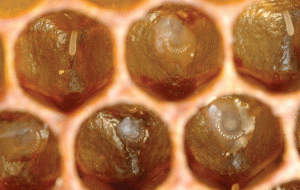
If a hive becomes queenless, the desperate search is on to purchase a queen before the hive dies out. This is by far the number one reason why queens are purchased without regard for the queens genetics. Breeders, because of demand pressure, do not always carefully monitor the genetics. The result is weak queens. The queens are compromised to meet demand.
Obtain a queen that is bred locally where bees survive the pests and diseases that are common to that location or learn to raise your own queens by breeding queen bees yourself to avoid the:
- travel distance and inherent shipping stresses.
- exposure to cold and hot temperatures that effect the health of the queen.
- delivery centers that may use pesticides.
- possibility of Africanized genetics from bees bred in the South.
Why do queens die?
- Crushed by the beekeeper
- Old or inferior
- Pesticides
- Diseases or viruses
- Insecticides
- More than one queen in a hive
- Mating flight (meal for a bird, rain or cold front)
Signs a colony needs a new queen or may swarm
- poor laying pattern
- only drone brood
- if you see queen cells: swarm cells (lower frame ) or supersedure cells (upper frame)
How to determine if a colony is queenless (these are general guidelines)
- Learn to listen to the colony. A queenless colony is louder, more agitated and busier.
- No eggs. Even when a queen is present, if there are no eggs then the hive is queenless. If you have a Russian or Carniolan colony the queen shuts down egg production when resources are low. Look intently for the queen.
- Only sealed brood present, hive has been queenless for more than a week. If there are no queen cells the colony is not able to raise its own queen.
- Unsealed brood present, brood is sealed on day 8 – hive has been queenless for less than a week. Look for 3 day old eggs, if present, the colony will raise its own queen
- If you have eggs, (eggs that have not curled into larvae) the queen is somewhere in the hive
- No brood – This is an emergency. The population will continue to dwindle until the colony dies out
How to remedy a queenless colony
- Purchase a new, mated queen (7-10 days delay in egg laying) or
- Allow the colony to raise their own queen (26-36 days delay in egg laying)
There are many ways to breed queens. Here is one step-by-step process called grafting.
Grafting
Step 1: Assemble grafting equipment
- Clean grafting tool
- Cooler with damp towel
- Very bright light
- Magnifiers if vision is less than 20/20
- Royal jelly (plain yogurt can be used or harvest from other cells with a hypodermic needle)
- Cell cups
- Cell frame
Step 2: Assemble a queenless cell starter nuc
- 5 frame nuc (wood or cardboard)
- 1-2 frames drawn comb (with or without brood is debated)
- 2-3 frames honey & pollen
- Pack full of young nurse bees
- Note: If a honeybee has its head pointed inside a cell she is a nurse bee cleaning out a cell.
Step 3: Select a hive for grafts
- Select a colony: Disease free Mite free Over-wintered 1-2 years Strong honey production
- Remove a frame with 2-3 day old larvae – brush off bees and place in cooler with damp towel
- Gently transport cooler to well-lit grafting area
- Prime the cell cup with royal jelly
- Work quickly to graft 20 cells
- The larvae must rest in the same position from cell to cell cup so that the larvae can breathe
- Place grafting frame into the cell starter nuc
- Monitor the resources for 8 days. Cells should be capped by day 8.
Step 4: Assemble a mating nuc for each capped queen cell
- 5 frame nuc (wood or cardboard)
- 1-2 frames drawn comb (with or without brood is debated)
- 2-3 frames honey & pollen
- Plenty of honeybees
- As soon as the cells have been capped the queen cells can be moved to the mating nuc
- The nucleus hive can be sold once the queen has been laying for 21 days.
- Note: when selling queens a small mating nuc is used to quickly locate and capture the queen
Stay tuned for more information on raising your own queens.
COLONY SPLITS
Content being updated. (Send me an email to remind me to update this section.)
THE HONEY PROCESS
an annual timeline of activity in the bee yard
Honey is extracted at the end of August. The honey supers are taken from the hives and stacked inside the honey house for extraction. The comb is shaved with a hot knife and then loaded into the extractor. The drum spins for several minutes while the honey drips from the drum into a filter. Once filtered; the honey is bottled, capped and labeled. Extraction is an all-hands-on-deck event. The process is slow, hot and sticky.
After extraction the supers are placed back on the hives for the bees to clean the comb. After the first frost we remove the empty honey supers for winter storage. At the winter solstice (between December 20-23), the hives are winterized and the winter candy boards and ventilation system is placed on the hives.
“One can no more approach people without love than one can approach bees without care. Such is the quality of bees…” — Leo Tolstoy
POLLINATOR PLANTS
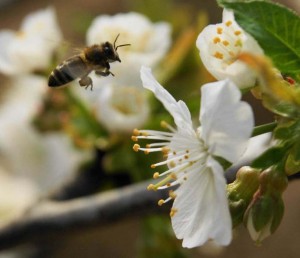 Your choice to buy organic products from a local farmer and your willingness to grow bee friendly plants helps to maintain a healthy environment, vibrant community, and a strong local economy.
Your choice to buy organic products from a local farmer and your willingness to grow bee friendly plants helps to maintain a healthy environment, vibrant community, and a strong local economy.
Beekeepers need everyone to help increase the honeybee population. Bees pollinate one third of the world’s food supply yet colonies are disappearing at alarming rates in many parts of the world due to the cumulative effects of parasitic mites, viral and bacterial diseases, and exposure to pesticides and herbicides. Large scale chemical application is toxic to soil and water, and weakens our honeybees.
If you have a yard, the choices you make in your landscape and garden can support honeybee health. Attracting honeybees to a garden will help the productivity of plants through pollination. Plan a garden to provide pollen and nectar sources over an entire growing year. Even on a warm late winter day, honeybees need pollen sources to feed young brood in the hive. Plant for year-round blooming and in relative proximity to a beehive.
Honeybees commit themselves to one plant type
If dandelions are blooming at the same time as the apple trees, the honeybee will select the nectar that the colony prefers and will fully exhaust that nectar source before moving on. It is advantageous then, to cultivate one crop and plant it en mass. Workers will favor the plants that are closest to the colony. Single blossoms with anther and stamen easily accessed within the petal are better than double or trumpeted blossoms since the honeybee’s proboscis is not very long.
What plants do bees see?
Bees can see ultra-violet light and favor purple and blue flowers. Bees do not see red flowers but will be attracted to a red flower where ultra-violet light is present or there is high contrast between a flower and its background.
What plants are most nutritious?
Heirloom and wild flowers provide the most nectar and pollen while hybrids lack sufficient nutrition. A hybrids color may be vivid but its nutritional source leads the honeybee on an unproductive journey. The honeybee is driven to the sunflowers yet new pollen-less sunflowers are marketed for longer living floral arrangements.
Native versus Non-native Plants
Bees will pollinate plants that are not native to an area but are inefficient non-native plant pollinators. It is important to select plants that are local. Listed below are plants that honey bees will pollinate effectively. Not all of these plants grow in every location. According to the USDA, Washington Island is in zone 5A. When selecting plants the farm uses zone 4. Find your own zone at the National Gardening Association. If you see a plant not listed in our database below, and it is a bee friendly plant, send us the plant name so that we can build a comprehensive database. (add a plant here).
POLLINATOR PLANTS
| A | B | C | D-L |
| Acer Maple | Basil | Cabbage | Dandalions |
| Acerola | Basket-of-Gold (Aurinia saxatilis) | Cantaloupe | Digitalis |
| Ageratum | Basswood – Linden | Carambola | Dogroses |
| Ajugas | Bean Adzuki | Caraway | Echinacea |
| Alfalfa | Bean Broad | Cardamom | Echinops |
| Allspice | Bean Goa | Cashew | Eggplant |
| Almond | Bean Haricot | Catalpa (Indian Bean Tree) | Elderberry |
| Apple | Bean Kidney | Catnip | Fennel |
| Apricot | Bean Lima | Cauliflower | Flax |
| Asparagus | Bean Mungo | Celery | Foxglove |
| Aster | Bean Scarlet Runner | Cherry Sour | Geranium |
| Avocado | Bean String | Cherry Sweet | Globe Thistle |
| Beet | Chestnut | Glory of the Snow | |
| Bergamot | Clematis | Goldenrod | |
| Blackberry | Chinese Cabbage | Gourd | |
| Bleeding Heart | Chives | Grape | |
| Blueberry | Clover (not all species) | Guava | |
| Bluebells (bulb) | Clover Arrowleaf | Hazel Alder | |
| Boltonia asteroids | Clover Crimson | Hazelnut | |
| Borage | Clover Red | Heather | |
| Boysenberry | Clover White | Heath | |
| Broccoli | Coconut | Hebe | |
| Brussels Sprouts | Coffee | Helleobors | |
| Buckwheat | Calendula | Hyacinth | |
| Coneflower | Inkberry | ||
| Coriander | Jacob’s Ladder | ||
| Cosmos | Joe-Pye Weed | ||
| Cotton | Jujube | ||
| Cranberry | Karite | ||
| Crocus | Kiwifruit | ||
| Crownvetch | Lavender | ||
| Cucumber | Leopard’s Bane | ||
| Currant Black | Locust | ||
| Currant Red | Loosestrife | ||
| Lupine | |||
| M-P | Q-S | T-Z | |
| Macadamia | Quince | Tamarind | |
| Mango | Rambutan | Tangelo | |
| Marrow | Rapeseed | Tangerine | |
| Milkweed | Raspberry | Thrift | |
| Mint | Rose Hips | Thyme | |
| Mignotette | Rosemary | Tung Tree | |
| Monarda | Rowanberry | Turnip | |
| Mountain Bluet | Rudbekia | Verbena Bonariensis | |
| Mustard | Safflower | Vetch | |
| Nectarine | Sage | Viburnum | |
| Nut | Sainfoin | Walnut | |
| Okra | Salvia | Watermelon | |
| Onion | Scabious | Willows – Salix | |
| Oregano | Sedums | Winter Hazel | |
| Papaya | Sesame | Witchhazel | |
| Pea, Black-eye | Snapdragon | Zuchini | |
| Pea, Cowpea | Soybean | ||
| Peach | Squash | ||
| Pear | Starfruit | ||
| Pepper Bell | Strawberry | ||
| Pepper Chili | Sumac | ||
| Pepper Green | Sunflower | ||
| Pepper Red | Sweet William | ||
| Persimmon | |||
| Plum | |||
| Plum Hog | |||
| Pomegranate | |||
| Poplar (Yellow or Tulip) | |||
| Poppy | |||
| Primrose | |||
| Pumpkin, |
